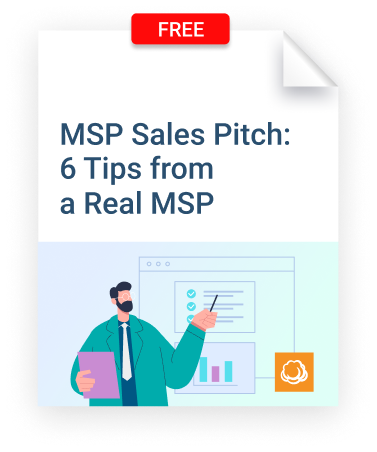Small and medium businesses routinely don’t spend money on IT issues until there is a pain point that can no longer be avoided. They are focused on finding new customers, delivering services and keeping the lights on. For some, the world of software, servers, and networking is far from their comfort zone, or their interests.
They will, however, partner with a regional MSP that is talking their language and gives them assurances that they have solved all this before. Most are open-minded about out-tasking basic operations and building out some rented infrastructure on a pay-as-you-go model.
MSP sales procedure is an interactive process that is best served by some predictable probing questions early in the sales cycle. Be it a chain of pizza stores, an eCommerce site selling jewelry or a group of dentists, there are predictable common pain points to start the conversation. Seize on opportunities to differentiate your value by resolving real and perceived obstacles to success.


Hit all these common SMB pain points and shape your sales pitch based on feedback.
1. Completing Daily Operational Tasks
 Growing businesses must focus on core competencies to service their clients. Many are not versed in server revisions, the latest security vulnerabilities or optimum backup schedules. Most will struggle to justify, attract and retain top IT talent for the expertise they may need intermittently throughout the year. Daily, weekly and monthly operational tasks like backups, patching and event log examinations may not be automated. The few persons having these overwhelming responsibilities are often working on a best efforts' basis. The results can be mixed so the MSP can demonstrate it's value by taking away repetitive operational tasks and consistently delivering IT stability.
Growing businesses must focus on core competencies to service their clients. Many are not versed in server revisions, the latest security vulnerabilities or optimum backup schedules. Most will struggle to justify, attract and retain top IT talent for the expertise they may need intermittently throughout the year. Daily, weekly and monthly operational tasks like backups, patching and event log examinations may not be automated. The few persons having these overwhelming responsibilities are often working on a best efforts' basis. The results can be mixed so the MSP can demonstrate it's value by taking away repetitive operational tasks and consistently delivering IT stability.
2. The Cost of Downtime
 Ask your prospect about the longest outage they have had, the root cause and how did they resolve it. It’s likely that they know the total cost and some lessons learned. Explore if the true cost is more than internal productivity. It could have been a loss of revenue and reputation from new or loyal clients. Explain that in today’s cloud environments downtime can be virtually eliminated with the right planning and design. Proudly prove you routinely meet the SLA of similar-sized clients in a managed service. Point out the recent advances in automated backups technology and how disaster planning is a critical investment against natural disasters, hardware failures, and security attacks.
Ask your prospect about the longest outage they have had, the root cause and how did they resolve it. It’s likely that they know the total cost and some lessons learned. Explore if the true cost is more than internal productivity. It could have been a loss of revenue and reputation from new or loyal clients. Explain that in today’s cloud environments downtime can be virtually eliminated with the right planning and design. Proudly prove you routinely meet the SLA of similar-sized clients in a managed service. Point out the recent advances in automated backups technology and how disaster planning is a critical investment against natural disasters, hardware failures, and security attacks.
3. Basic Security
 Most small and medium businesses are not security savvy or aware of common risks and the latest vulnerabilities. The pain point is in the uncertainty of where to start and stop investing in data center security knowing it will distract from core business activities.
Most small and medium businesses are not security savvy or aware of common risks and the latest vulnerabilities. The pain point is in the uncertainty of where to start and stop investing in data center security knowing it will distract from core business activities.
There is an expanding opportunity for MSPs to offer growing managed security services options such as firewalls, intrusion protection, web scanning and reporting while leveraging existing ticketing and change management tools. While moving from a break-fix model to managed cloud services the MSP may need to hire or partner with local talent.
Further reading 3 Reasons Why Selling Cybersecurity to the SMB is a Challenge (and What to Do About It)
4. Time to Market
 Launching web applications in support of new products can be a daunting task for most SMBs. New IT projects often require additional space, power, CPU, storage, licensing and secure internet connections. MSP’s ready resources can greatly reduce the total project times by providing infrastructure and platforms.
Launching web applications in support of new products can be a daunting task for most SMBs. New IT projects often require additional space, power, CPU, storage, licensing and secure internet connections. MSP’s ready resources can greatly reduce the total project times by providing infrastructure and platforms.
The client’s resources are then freed up to be creative and solely concentrate on the development of new services and features. MSP platforms can be ready for business in hours or days and not weeks or months via an internal ‘do-it-myself’ project methodology.
5. Certifications and Compliance
 For merchants handling or storing cardholder information, the Payment Card Industry Data Security Standard (PCI DSS) likely applies to them. Most have heard that having a data breach while not being PCI compliant could bring large fines. Often this remains mysterious nagging pain point until the mid-sized organization embraces the requirements. MSPs can assist clients with the PCI Self Assessment and even perform some certification requirements within the Managed Service offer like firewall, identity and encryption services. The MSP can assume some components of compliance through automated processes performed by industry certified staff.
For merchants handling or storing cardholder information, the Payment Card Industry Data Security Standard (PCI DSS) likely applies to them. Most have heard that having a data breach while not being PCI compliant could bring large fines. Often this remains mysterious nagging pain point until the mid-sized organization embraces the requirements. MSPs can assist clients with the PCI Self Assessment and even perform some certification requirements within the Managed Service offer like firewall, identity and encryption services. The MSP can assume some components of compliance through automated processes performed by industry certified staff.
A similar painful mystery occurs with compliance with the Health Insurance Portability and Accountability Act (HIPAA). Health care providers, clearinghouses, and health insurance providers have requirements that can be out-tasked to the MSP’s infrastructure and quality processes.
Listen, Invest and Grow.
Consistently the SMB clients have lean IT teams with similar pain points. Depending on the vertical you may be focused on, your opportunities to grow corresponds to your MSP’s ability to replace obstructions with solutions. Careful not to get too technical early in the conversation, it may put them out of their comfort zone. Gaining the prospect’s trust while understanding of their pain points will tell you what level of services to pitch.






